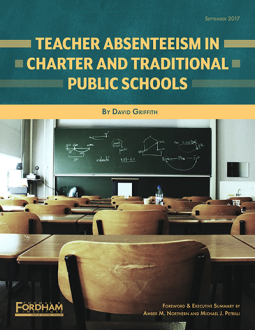Research confirms what common sense dictates: Students learn less when their teachers aren’t there. According to multiple studies, a ten-day increase in teacher absence results in at least ten fewer days of learning for students.
Clearly, some absences are unavoidable—teachers are only human. But compared to their counterparts in other industries and other countries, U.S. teachers seem to have poor attendance. On average, they miss about eight school days a year due to sick and personal leave (in addition to the breaks they get for school vacations and national holidays); meanwhile, the average US worker takes about three-and-a-half sick days a year. Yet the first of these averages obscures the degree to which absenteeism is concentrated among a subset of teachers.
In Teacher Absenteeism in Charter and Traditional Public Schools, Fordham senior research and policy associate David Griffith takes an unprecedented look at teacher chronic absenteeism rates in charter and traditional public schools—that is, the percentage of teachers who miss at least eleven days of school, excluding professional development days and field trips.His major findings include the following:
-
Nationally, teachers in traditional public schools are almost three times as likely to be chronically absent as teachers in charter schools: 28.3 percent versus 10.3 percent.
-
In eight states plus the District of Columbia, traditional public school teachers are at least four times as likely to be chronically absent as their charter school peers.
-
In thirty-four of the thirty-five states with sizable charter sectors—and in each of the ten largest cities in the country—teachers in traditional public schools are more likely to be chronically absent than teachers in charters.
-
The chronic absenteeism gap between charter and traditional public school teachers is largest in states where districts—but not charters—are required to bargain collectively.
-
Teachers in unionized charters are twice as likely to be chronically absent as teachers in non-unionized charters.
Overall, these results suggest that the high chronic absenteeism rates we observe for teachers in traditional public schools are at least partly attributable to the generous leave policies enshrined in state laws and local collective bargaining agreements—and that the chronic absenteeism rate in many places could be reduced without exploiting teachers. Consequently, as policymakers across the country move to tackle student chronic absenteeism through their ESSA accountability plans, we must ask: Why would we hold schools accountable for the attendance of their students but not of their own teachers? How can anyone expect students to learn when their teachers are absent?




